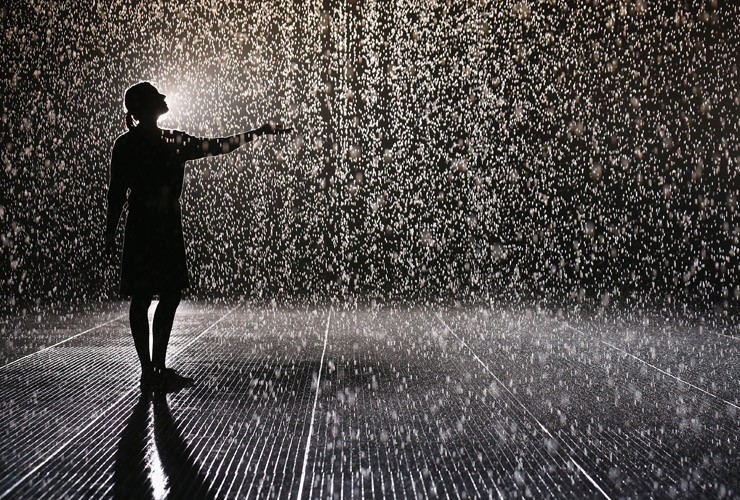Our Blog

Random International’s Rain Room (2012) is an immersive environment of perpetually falling water that pauses wherever a human body is detected. The installation offers visitors an opportunity to experience what is seemingly impossible: the ability to control rain. Rain Room presents a respite from everyday life and an opportunity for sensory reflection within a responsive relationship.
In the words of Raqs Media Collective:
“The best kind of art, like the rain, invokes a re-ordering of the cognitive and the sensory fields. It asks of its actual and potential publics to open doors and windows and let the other worlds in. This re-ordering–subtle slight, sure, sharp or soft as the case may be, whether it is a desultry drizzle across a few frazzled or jaded synapses, or the neurological equivalent of an electrical thunderstorm and sudden downpour — is why we bother with art in the first place. When it rains art, we do not reach for umbrellas. It makes sense to let ourselves soak, as long as we can, like children dancing in the season’s first rain.”
In the same vein, my art practice does not discriminate audiences in the application of art but almost always disrupts a habitual pattern to inspire a personal or social shift. As Creative Director of limeSHIFT, our art interventions have influenced empathy, community and leadership in private companies, universities and neighborhoods in Boston, Chicago, and New York City. Many of our working practices are directly informed not just by individual artistic processes, but also by the working modes of artist collectives.
Artist collectives have occurred throughout history, often gathered around central resources, for instance the ancient sculpture workshops at the marble quarries on Milos in Greece and Carrara in Italy. Collectives featured during both the Russian revolution when they were set up by the state in all major communities, and the French Revolution when the Louvre in Paris was occupied as an artist collective.
An artist collective is an initiative that is the result of a group of artists working together towards shared aims. These aims can include almost anything that is relevant to the needs of the artist, ranging from purchasing bulk materials, sharing equipment, space or materials, through to following shared ideologies, aesthetic and political views or even living and working together as an extended family. Sharing of ownership, risk, benefits, and status is implied, as opposed to other, more common business structures with an explicit hierarchy of ownership such as an association or a company.
The aphorism “a rising tide lifts all boats” is associated with the idea that improvements in the general economy will benefit all participants in that economy. Beyond sharing materials and ideologies, artist collectives have showcased time and again that collaborative processes tend to benefit all of the members of any given community.
